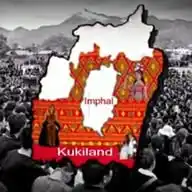
KUKI UNITED
June 21, 2025 at 10:21 AM
Ref.No. 185/WKZIC-GHQ/(PR)/2023-25
*WKZIC Response & Tutorial to FNCC*
20th June, 2025
This tutorial is hereby made with proofs and evidence to validate the credibility of Kuki History in response to FNCC Press Release vide Ref. Nill, dated, the 20th June 2025 as under, paragraph by paragraph.
*Keypoint:* _It is the French who knew best their (France) history, likewise the Englishmen knew best the history of England. And so ... Is it not funny that some ignorant Kacha Nagas always knew best Kuki history than the Kukis themselves??_
1. *Para - 01:* FNCC’s Vocabulary- ‘Pseudo’ in their opening PR and writings depicts FNCC themselves as Pseudo forum, having no outside contact and cocooned with their wild head-hunting mentality, with no valid proof, playing in the name of Naga. FNCC needs to refer the below documents and pictures to feast their ignorant eyes fully, to learn properly Kuki history which they are so interested and curious to know.
2. *Para - 02:* FNCC’s ‘Kuki Refugee’ terminology in the second para of their PR is purely the construct/invention of some evil minded Kacha Nagas. None of the Government of India and Government of Manipur Official Documents mentioned Kukis as Refugees. FNCC and Cohorts must know that the 1967 Repatriated Indian Origins, numbering 2,06,781 includes 1500 Kukis (displaced from Ukhrul, Senapati & Tamenglong during 1956-1966 by hostile Naga insurgents, WKP, Pp.) accounting to 0.7% only and the rest 99.3% belonged to Madrasis, Punjabis, Bengalese, Bhojpuris, Malayalese and Assamese etc, (Digital Library: Parliament of India, Lok Sabha, 1968).
Regarding the problems of FNCC alongwith some Kacha Nagas and some Meiteis’ *“Kukis Status of Indigeneity”,* the Government of India, Ministry of Culture, National Archives of India (NAI), Public Records Division, Janpath, New Delhi - 110001, vide No. NAI/PRD/2025/0753, dated, the 19th February, 2025 issued an Official Statement that “Kukis are Indigeneous Hill Tribes of Manipur”, as per J.H Hutton (Census of India 1931) and R. Brown (Statiscal Account of Manipur, 1873).
3. *Para -03 & 04: FNCC’s Ignorance on Khongjai Hills 1741-42 @ Kuki Hills (UK Parliament, 1921) & History of Kuki Hills (1852-1949):*
The Khongjai Hills Expedition of 1786 (Parratt, J. 1997, The Pleasures of the Past: A Social History of the Manipur kingdom from 1764- 1949, 1: 151-153, Vikas Publishing House) refers to the hills of the Khongjais. The expedition was led by King Chingthangkhomba through the Kuchu Valley who explored and encountered various Khongjai Villages (Cheitharol). Finally the Khongjais were subjugated, rendering the Khongjai villagers to visit the king and presented various gifts. The king erected a stone pillar at Tuyai Yirok and performed a spear dance in the centre of the Khongjai village (Cheitharol). The term Khongjai was derived from the name of the main village being attacked, was inhabited mainly by the Khongjai king and other clans of the Kukis, (William Shaw, 1929: 47).
Another evidence of the Kuki Hills is the ‘History of the Indian Mutiny 1857-1858’ (Col. G.B. Malleson, 1878) and *“The Sepoy War”* (John William Kaye, 1870) where most of the mutineers of the Indian Mutiny of 1857 were either killed or captured or perished miserably in the jungles of the MANIPUR and KUKI HILLS. Debates in the UK Parliament on Indian Affairs regarding ‘KUKI HILLS OPERATIONS 1917-1919’ on the 1st June 1921 by Secretary of State for India, Sir. C. Yate and Mr. Montagu’s statements on *“Kuki Hills Operations 1917-1919 Medal”* rectified their operations in Kuki Hills.
The book *‘History of Kuki Hills in Kanglei Manipur 1852-1949’* (Indigeneous People’s Publication, 2010) also minutely documented the Kanglei Manipur and its historical events and Meitei kings. The *‘Manipur Hill Territory’* was already inhabited by Hill Tribes resembling as Nagas and Mizo-Kukis (Ref:Meitei People- Encyclopedia Britannica @ https//www. brittanica.com) with 12 tribal Chieftaindoms (Ref: History of Kuki Hills (1852-1949) in Kanglei Manipur) such as:
1) Chahsat Chieftainship,
2) Laijang Chieftainship,
3) Molpi Chieftainship,
4) Tonghu (Tonglhu) Chieftainship,
5) Chothe Chieftainship,
6) Thayong Chieftainship,
7) Kharam Chieftainship,
8) Maring Chieftainship,
9) Langmai Chieftainship,
10) Makeng Chieftainship,
11) Maram Chieftainship,
12) Mapao Chieftainship respectively. It also include indepth informations on:
i) Kuki Hills & Kuki Ancestral Territory,
ii) Covenants & Agreements, iii) Military Expeditions,
iv) British Influences,
v) Kuki Identity & Politics, and
vi) Contemporary Relevances’.
4. *Para 5: Anglo-Kuki War 1917-1919 @ Kuki Rising or Kuki Rebellion:*
The problem of unsolicited FNCC (Foothill Naga Co-ordination Committe) and all its jealous Cohorts is that the warrior Kukis forgot to consult them while fighting the colonial British during 1917-1919, who invaded their *‘Ancestral Land’.* The fighter Kukis, who fought the war called it as *“Anglo-Kuki War 1917-1919”* by themselves, and the British documented it as *‘Kuki Rising 1917-1919’* and the Indian Historians recorded it as *“Kuki Rebellion 1917-1919”,* and the Meiteis called it as *‘Khongjai Lan’.* Kukis never needed the approval of unsolicited FNCC and cohorts in this matter.
As per the colonial document, “Colonisation, Identity and Search for Peace” the total troops employed on ‘Kuki Punitive’ measures from ‘British and Indian Officials’: Combatants: 3,223 (Assam) 3,022 (Burma), Total - 6,234. Non-Combatants: 346 (Assam), 350 (Burma), Total – 696, Transport Carriers: 4,600 (Assam), 3,050 (Burma) , Total – 7,650. The data of Kuki Punitive measures 1917-1919: is as follow: Nos. of surrendered- 140, Nos. of Kuki Villages burnt- 126, Deserted -16, Nos. of Kukis killed -120, Nos. of Mithuns (Gayal) killed/ died - 576, Nos. of Kuki Warrior leaders arrested and imprisoned- 15 from Assam and 12 from Burma.
*APPENDIX:* Khongjai Hills (1741-42) later called Kuki Hills (UK Parliament, 1921) & History of Kuki Hills (1852-1949) quartet into 4 regions including British Songpi Sub-Division 1919, are:
i) British Mombi (Lonpi) Area Map 1907: Vide. Map No. SA.1/2020/385,Vide Lib/R138/S1/13,
ii) British Chassad Area Map 1907: Vide. Map No.SA.1/2020/385,Vide Lib/R138/S1/63, and
iii) British Jampi Area Map 1907: Vide Map No. SA.1/2020/385,Vide Lib/R138/S1/12, respectively.
Issued by: Directorate of Information & Publicity,
*World Kuki-Zo Intellectual Council (WKZIC)-GHQ.*
_________________________
WKZIC-GHQ Channel Follow Link https://whatsapp.com/channel/0029ValUJiK6BIEmOG5UZA1i
